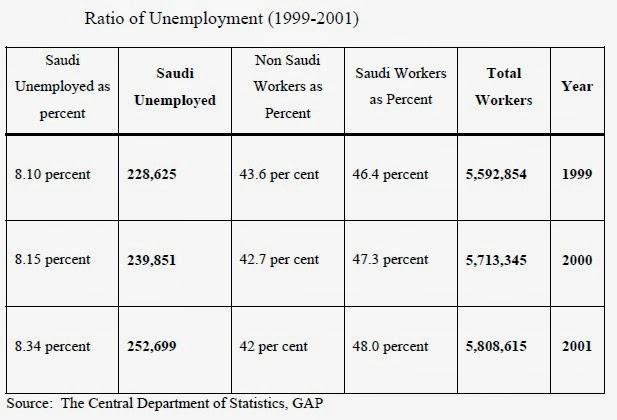The recent decades could be characterized by the growth of the role of countries of the Middle Eastern region at the international level. This process could be explained by the rapid growth of the economies of the given states and their involvement in the great number of the international process. However, the major concern connected with the increase of the influence of these states is related to the basis of their economies and the most important management strategies.
The reason for the appearance of this concern lies in the fact that these states depend on the oil extraction industry while the other sectors of the economy might stagnate. This situation is taken as threatening as the unbalanced evolution of the economy could lead to the collapse of the state and deteriorate the situation in the region. For this reason, Saudi Arabia reconsiders its strategies in the sector of the economy trying to guarantee its stable development (“Nitaqat review on the cards” para.2 ).
Nowadays, Saudi Arabia is one of the most powerful states of the region with a stable economy and power. It continues its evolution and is expected to continue its growth turning into a real power (Peck 2). The economic sector is characterized by the developed oil extraction and refinery industries which guarantee a high level of income. However, the other sectors are not developed and the state has to import several consumer goods to satisfy the needs of the population.
Finally, the strangle of the foreign workforce is another important trait of Saudi Arabias economy. At the end of 2006, the private sector of the state was occupied by the workers from South Asia and Arabian countries of the region (Alshanbri, Khalfan, and Maqsood 899). At the same time, the unemployment rate among the citizens of the kingdom was high. This situation posed a great threat to the further evolution of a country.

The practice of saudization is related to the given problem and is aimed at its resolution. It identifies the replacement of the foreign workforce with Saudi nationals in the private sector of the state (“Labor and the Nitaqat program: effect on the Saudi Arabian Economy” para. 1).
Saudization aims at the reduction of the level of unemployment and the creation of the beneficial conditions for the youth of the Kingdom. The reasons for the implementation of the given plan also included the growth of the economy and the improvement of the position of women in the kingdom. The government expected the significant shifts in the structure of the workforce in the private sector and reconsideration of the policies used by companies. Organizations that failed to follow the main concepts of saudization had to be deprived of the government contracts and imposed fines to compensate for the damage caused to the state and its working force (Peck 5).
Saudization served as the basis for the Nitaqat program introduced by the Ministry of Labor. This program structured the above-mentioned practice and clarified certain terms and conditions. It implied several phases:
Table 2. Nitaqats phases (“Labor and the Nitaqat program: effect on the Saudi Arabian Economy” 2).
The table demonstrates the terms and the main goals of the program. The phases of the given strategy are created to make the process more structured and underline the priorities of the government.
To be more efficient and flexible the given strategy classifies companies that belong to the private sector into four categories: premium, green. yellow and red (“Labor and the Nitaqat program: effect on the Saudi Arabian Economy” 3).
This pattern is based on the saudization rate within the company. An organization related to the premium or green category is characterized by the high saudization rates and could feel comfortable in terms of the kingdoms environment. Although, the red and yellow categories signalize that the amount of Saudi workers working in the company is not enough and some measures should be introduced.

The list of sanctions for companies that belong to the red sector includes the prohibition to get new visas, to renew employees work permits, etc. (“Labor and the Nitaqat program: effect on the Saudi Arabian Economy” 5). The nature of sanctions evidence that their main goal is the protection of the interests of the citizens of the state and make a company follow the main concepts of the program. These sanctions are challenging in terms of Saudi Arabia’s working environment and might lead to a significant deterioration of the performance of the company. The given penalties make various companies aim at the reconsideration of its functioning and its classification as the premium one. This group of companies does not have penalties and is allowed to hire foreign workers.
The program has given rise to numerous debates around the position of foreign workers in Saudi Arabia. About 90000 Indians had to leave Saudi Arabia by the end of 2013 (Peck 34). It helped the Saudi workers to find the appropriate job and contribute to the evolution of the economy of the state. However, the problems remain and the unemployment rate is high. This fact proves the necessity of the continuation of the given program (“New phase of Nitaqat announced” para. 2) and the need for the further improvement of the situation in the private sector of the Saudi Arabian economy.
Works Cited
Alshanbri, Nawaf, Malik Khalfan, and Tayyab Maqsood. “Localization Barriers and the Case of Nitaqat Program in Saudi Arabia.” Journal of Economics, Business and Management. 3.9 (2015): 898-903. Web.
Labor and the Nitaqat program: effect on the Saudi Arabian Economy. n.d. Web.
“New phase of Nitaqat announced“. Arab News. 2015. Web.
“Nitaqat review on the cards“. Arab News. 2015. Web.
Peck, Jenifer. Can Hiring Quotas Work? The Effect of the Nitaqat Program on the Saudi Private Sector. 2014. Web.
What is Nitaqat system in Saudi Arabia?. n.d. Web.